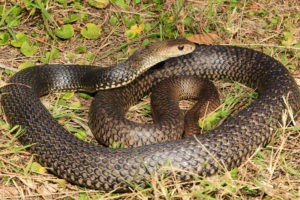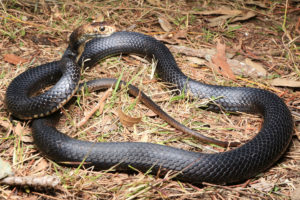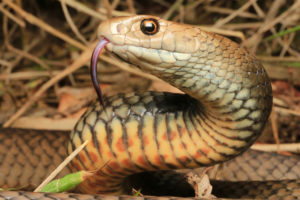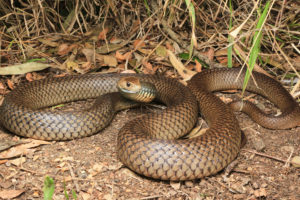Pseudonaja textilis
VENOM: Dangerously venomous, seek emergency assistance if bitten.
SIZE: Growing to 2.2m (Avg 1.5m)
LOCAL DISTRIBUTION: The Eastern Brown Snake is a commonly encountered snake species throughout the Gold Coast, Brisbane & Scenic Rim regions, particularly within drier areas.
HABITAT: Eastern Brown Snakes reside in a diverse range of habitats including dry sclerophyll forests, open grasslands and coastal heath. Suburban and agricultural areas are favourable for this species as rodents are normally abundant.
Around the home the Eastern Brown Snake is most commonly encountered foraging in gardens during warm weather. Rock walls, ground lying debris and concrete slabs with cracks and cavities provide ideal locations for these snakes to hunt and shelter.
GENERAL DESCRIPTION: These snakes come in various shades ranging from black, brown, grey, orange and terracotta red. Contrary to popular belief, Eastern Brown Snakes can also be heavily speckled and/or banded in appearance. The belly is generally cream in colouration with distinct orange spotting. Juvenile Eastern Brown Snakes will usually have a dark brown or black band across their nape.
ADDITIONAL NOTES: During a threat display Eastern Brown Snakes raise the first third of their body off the ground in an ‘S’ position, before striking. After each mating season pregnant females will give birth to a clutch of approximately 16 eggs.
SIMILAR LOOKING SPECIES: MARSH SNAKE, YELLOW FACED WHIP SNAKE, BROWN TREE SNAKE, KEELBACK, DWARF CROWNED SNAKE.
It’s important to realise that many species of snake can vary in colour, pattern and size. This often makes it very hard to make a positive identification of the snake. You should always assume that a snake is highly venomous, keep your family and pets at a safe distance and call a Gold Coast snake catcher.



